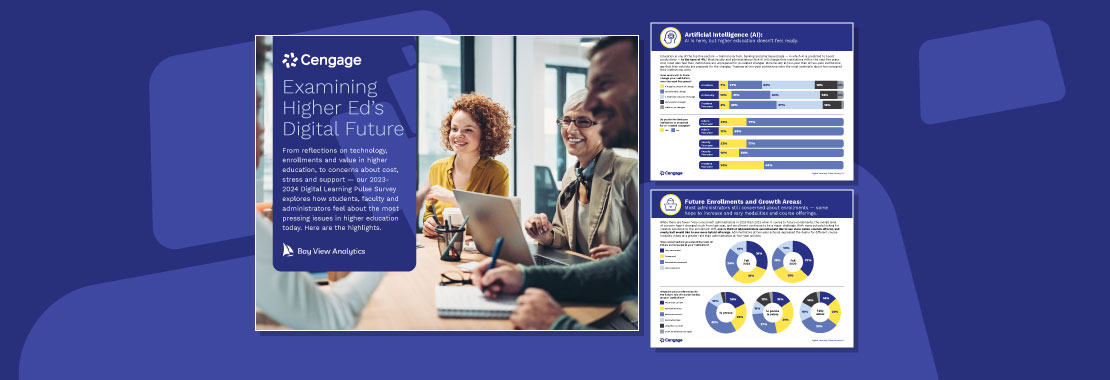For the last four years, we’ve checked in with students, faculty and administrators from two- and four-year institutions around the country to gauge what’s happening in their worlds and how they feel about some of the biggest issues facing higher education. This year, with AI no longer a distant hypothetical but a tangible presence in all our lives, and with ongoing debates about the cost of college waging, we were especially interested in what our respondents had to say. Here’s a look at the highlights from our latest Digital Learning Pulse Survey, in the categories that matter most to those in higher education.
AI: Ready or not, here it comes
Many students are using it. Some faculty are banning it. All institutions are scrambling to define policy for it. Like it or not, AI is here and its presence will be felt in higher education in the coming months and years. In our latest survey, most faculty and administrators said they think AI will change their institutions within five years. Yet, most of both groups also said they don’t think their institutions are prepared for AI-related changes. The takeaway? That policy piece will be exceptionally important to ensure that anyone within the fold of an institution understands both the limitations and the possibilities of AI usage on campus.
The enrollment cliff: It’s not going anywhere. Now what?
With 2023 freshman enrollments down by 3% in the fall after dramatic drops over the past few years, the demographic cliff is an intimidating phenomenon for those at the helm of colleges and universities. According to our survey, enrollment worries are (still) acutely felt by most administrators. Some 86% said they are either very concerned, concerned or somewhat concerned by the level of future enrollments at their institution.
Beyond simply being concerned about it, we were eager to learn what higher education leaders are planning to do to solve it. Varying the types and modalities of course on offer is a strategy many institutions employ to attract new students. We learned that over a third of administrators would like to see more online courses offered at their institutions, and nearly half would like to offer more hybrid courses.
Value: It depends on school type
With the ongoing debate about the cost of college, it’s important to understand the value students feel they are getting from their higher education experience. Generally speaking, the number of students who give their courses an A grade for educational value has trended upwards since 2020. A closer look, however, reveals different perspectives between students at two- and four year institutions. The number of four-year students giving their courses an A rose from 44% in 2021 to 54% in 2022, and dipped slightly to 51% in the most recent survey. On the other hand, there has been a downward trend in the number of two-year students giving their courses an A in the same period – 53% in 2021, 49% in 2022, and 45% in 2023 .
Cost: It’s out of hand and out of reach, but more leaders and educators than students are very concerned
As in past surveys, nearly everyone agreed that the cost of higher education is a major issue. Yet, while 70% of students agreed that the cost of education is becoming financially out of reach, more students were neutral on the matter than faculty or administrators (18% of students were neutral, vs. 10% of faculty and 11% of administrators). More faculty and administrators than students said they “strongly agree” that the cost of higher education is a problem (46% of faculty and 41% of administrators, vs. 32% of students.)
On stress
With mental health crises on campuses at an all-time high, it’s clear that students are experiencing a good amount of stress in their lives. Most respondents, in fact, said stress is a top barrier. Are institutions helping stressed students? While two- and four-year schools may indeed have mental health support services available for students in this area, a third of students (35% at two- and 25% at four-year schools) said they are unaware of their existence.
On institutional support
Speaking of support, we wanted to understand how students feel about the general support services available to them at their institutions. We learned that, while most students across school types said they are satisfied with the academic advising services their school provides, fewer felt positive about services like financial aid, career guidance, or health and wellness.
The Digital Learning Pulse Survey is an ongoing research series developed by Cengage and Bayview Analytics, exploring the digital learning transformation and evolution of colleges and universities. Read the latest Digital Learning Pulse results here.

